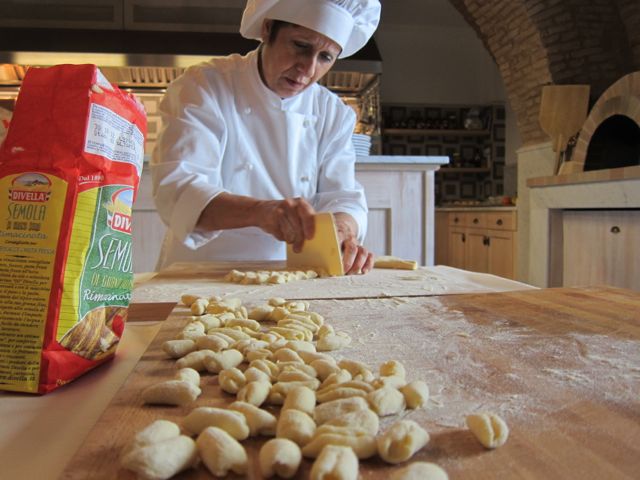
I admit it. Pasta scares me. Not cooking pasta. And certainly not eating pasta. But making pasta. Scary.
You’d think that after most of my life spent in Italy in the food world that I’d be flinging sheets of pasta right and left. But up until now the only thing I was flinging around was flour and water, and making a mess of it in the process.
The thing is, pasta making takes technique. It’s not really something that you can read about in a book and ‘get’ the first time around. It helps to take lessons. I’m big on reading, and rarely sign up for classes about anything (the whole Bonci pizza and bread thing was not the norm for me) And so even though I always thought about taking a pasta making class, plans never turned into reality.
Until I found myself with two free hours in Palazzo Margherita a couple of months ago.
Palazzo Margherita is Francis Ford Coppola’s newest hotel, and I was there checking it out for Travel & Leisure. So even though I was intent on the design, the amenities, the sheets and everything else that goes into making a hotel “It List” worthy, you can bet what I was really interested in was what was going on in the kitchen.
And this is where Filomena and my pasta epiphany comes in. As one would expect from any award winning director, Coppola has cast his latest project perfectly. And while the gracious staff makes a stay at Palazzo Margherita a dream, the pivotal role is played by Filomena.
The great thing about Palazzo Margherita is that it really feels more like a home (ok, a millionaire’s home) than a hotel. There are living rooms, terraces, gardens and all sorts of communal spaces that are cozy, warm and inviting. And like any home, eventually everyone ends up in the kitchen. Where Filomena holds center stage.
Although I guess Francis could have shipped in a fancy chef from anywhere in the world, he realized that the beating heart of the Palazzo would be the kitchen and so chose a local nonna to bring it to life. Running things with warmth and skill, Filomena is just the kind of Italian nonna that you are hoping to find. One that will insist you sit down at the kitchen table while she serves you the most delicious, local food you can imagine.
I was lucky enough to enjoy both lunch and dinner at the big wooden table that takes up half the room (more on that later). And although I’m sure Filomena had her hands full cooking, she generously put down her pots and pans, and pulled out her flour to give me a cooking lesson that cured me of my pasta fears, once and for all.
I’m not going to write up a formal recipe, since there are just two ingredients: flour and water. And more to the point, I made a short video that will have you making pasta in no time (remember, it’s all about technique). Although we worked on a few different shapes, it was the rucola that I fell in love with. Even though it looks all kinds of complicated, it couldn’t have been easier to make.
The Flour: this is semola di grano duro. Easy to find in Italy, it is called coarsely ground durum wheat flour in the States.
The Water: It must be boiling. Do not use cold water.
Place a half kilo/1 pound of flour in a mound on a floured board. Make a well in the center and slowly start adding the boiling water. Using a metal spatula, start pulling in the flour, mixing and adding more. Add only enough water until you get a springy consistency. As Filomena says “You can just feel it.”
After kneading it for a while, until it is silky smooth, break off a piece of dough and roll it into a tube about the diameter of a finger. Using the metal spatula or knife, cut off half inch pieces.
Once you have the pieces cut off it’s time to shape the pasta into rucola. There is really no easy way to explain in words how this is done. Using your index finger, drag each piece across the wooden board, so that it curls up on itself.
Just watch the video. Watch it a few times and then watch it again. 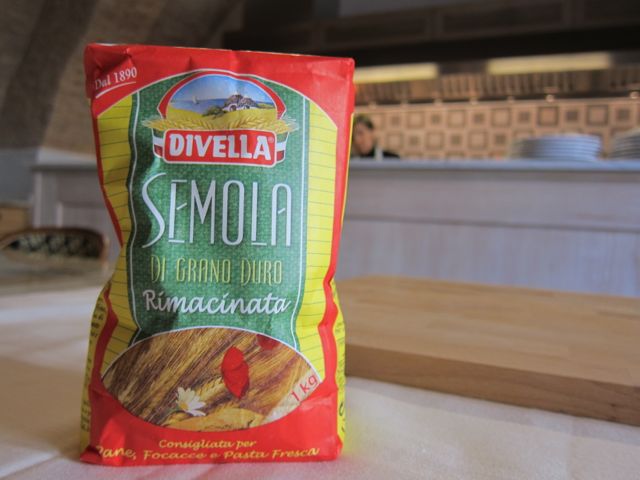
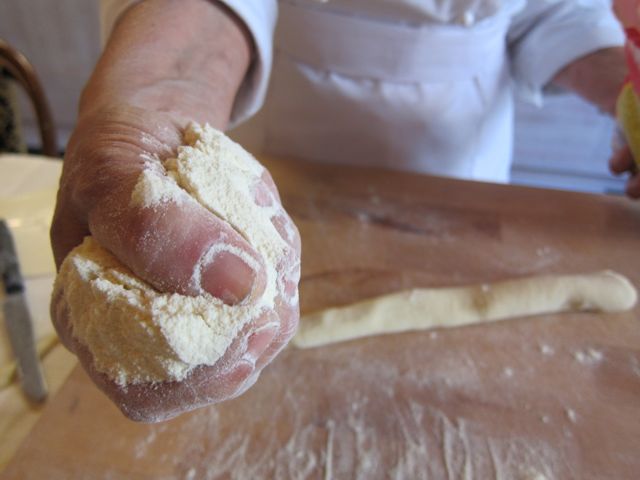
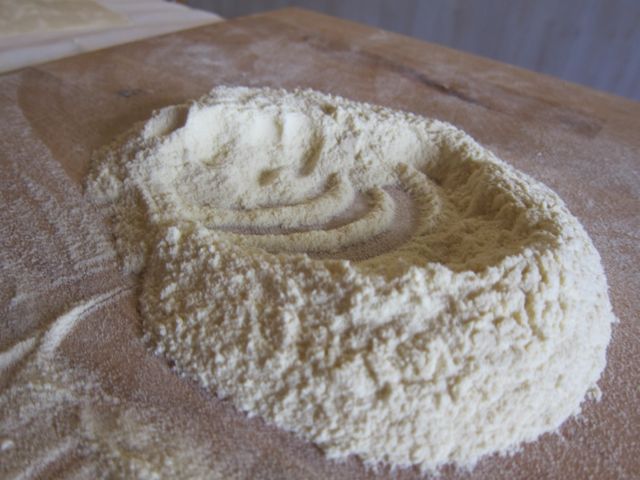
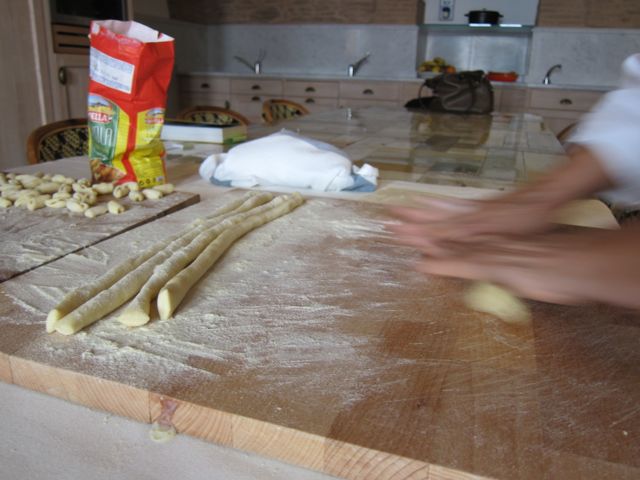
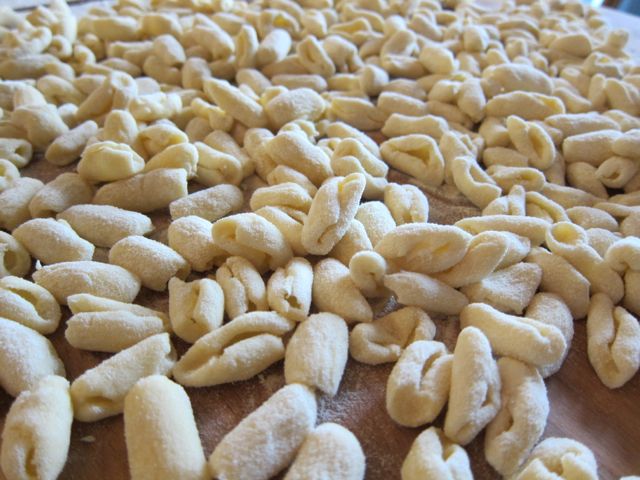
Once you get the hang of it it really is pretty easy.
This is the perfect starter pasta. There are no eggs to worry about, and as long as you don’t burn your hands with the boiling water, the mixing is pretty straight forward. There is no rolling out of paper thin sheets of pasta that tear at the slightest touch. In fact, working this dough is a lot like playing with play doh.
And the making rucola thing? Once you start going, it’s actually a lot of fun. Not at all scary.
Promise.
Just the way Mom used to. The video is fantastic, E.
Thanks!
Elizabeth,
I love making home-made Cavatelli! I typically roll the pasta with my thumb (a trick I learned from my dad), but whatever you do, these little guys come together fast.
The other great thing about them, is that they freeze really well. I freeze them on a cookie sheet, and then transfer them to a freezer bag. Whenever I want some, I just grab a handful. No need to defrost before cooking.
Michelle
Great idea to freeze them.
Elizabeth,
Not relative to anything on this post, I just returned from an eight day holiday in Rome (and Capri) on Saturday. Prior to the trip, I read your posts religiously (along with your app). My wife and our travelling companions had a wonderful time because I was able to plan in advance all of our restaurant stops. We dined at Glass, Dal Bolognese, Roscioli and many more to numerous to mention. All were terrific as we weren’t going to settle for mediocre food. The best restaurant by acclaim for our group was Roma Sparita in Trastevere. Forget the cacio e pepe which was top notch, the entire experience was so great that we had to go back a second time. Thank you so much for your help. We didn’t make Perilli but that’s at the top of the list for the next time. Grazie mille.
Mike
Happy to hear you had a great trip.
Thank you for tis tutorial. I have been trying to replicate my grandmother’s “cingul” (she was from Calitri in Campania) and I didn’t know about using boiling water. I am going to try this method. I wish I was on my way to stay at the palazzo!
WOW!! A revelation! The boiling water is completely intriguing as well as news to me. The heat must some how act on the gliadin, perhaps as a super-activator. I see a research project on my horizon. Filomena is pretty deft with her bench scraper.
I can always depend on you for very generously sharing complete info, and that one last little tidbit that marks the difference between success and failure, in this case, the boiling water. I have very much enjoyed the views inside Palazzo Margherita. As you know, I have been intrigued by it ever since I first heard of it.
You’ll be happy to hear more inside views of Palazzo coming up soon!
Dear Elizabeth, you are a genius for putting this incredibally interesting blog together for all of us. And these lovely people, these Italian artisans, working so simply, are geniuses, as well. I love the saying, “live simply, so others may simply live”. So true in this you tube video and with all of Italy. That is why we all love it so much. Ciao, Judy
Thanks so much Judy, for your extremely kind words. The blog is very easy, because there are so many great things to write about here!
Can you suggest a condimento for this type of pasta?
Yes, I can….and that’s coming up in a future post! But in the meantime, even a simple tomato sauce would work well.
Posso suggerire l’utilizzo di farina del Senatore Cappelli, io la trovo eccezionale specialmente per le “manate”, se tornerai per il volo dell’angelo saro’ felice di mostrarti la pasta piu’ magica della Lucania. A presto.
Great video, should have joined you for lunch, do you know what month
you article will be in T&L?
I went ahead and tried this method using boiling water and had great success. Thank you again!
Making pasta still intimidates me, but I think I can handle this recipe.
Great video.
Elizabeth: I’ve been reading your blog faithfully since I discovered it and can’t wait to try this method of making pasta. I assume you can dry these cavatelli, correct? I’m just wondering because my Roman and Abruzzese grandmothers, aunts and mother all made pasta with eggs and flour and always dried them.
Yes, you can absolutely dry them (and see my most recent post for that: http://www.elizabethminchilli.com/2012/05/bari-vecchia-buying-pasta.html) but you can also freeze them, which is what I do all the time.